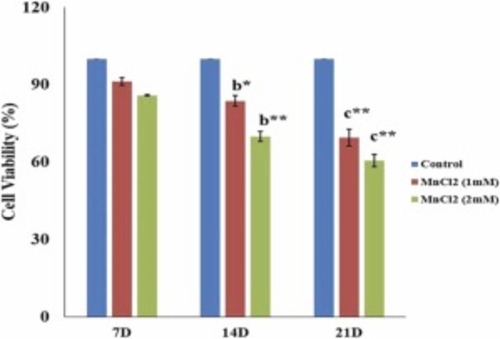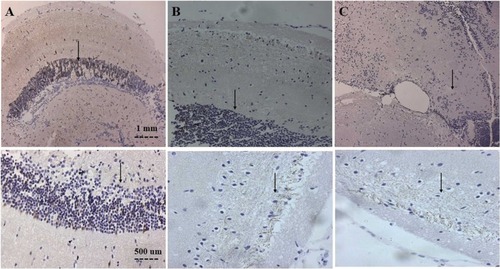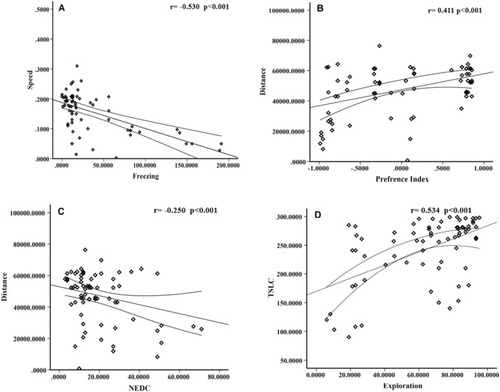- Title
-
Manganese chloride (MnCl2) induced novel model of Parkinson's disease in adult Zebrafish; Involvement of oxidative stress, neuroinflammation and apoptosis pathway
- Authors
- Nadig, A.P.R., Huwaimel, B., Alobaida, A., Khafagy, E.S., Alotaibi, H.F., Moin, A., Lila, A.S.A., Suman, ., M, S., Krishna, K.L.
- Source
- Full text @ Biomed. Pharmacother.
|
Fig. 1. Pathophysiology of Mn-induced PD. Fe2+: Ferrous ion; Tf: Transferrin; Mn2+, Mn3+: Manganese in the oxidized state. |
|
Fig. 2. Effect of prolonged exposure of MnCl2 on ZF. |
|
Fig. 3. Evaluation of MnCl2 chronic exposure effect on ZF to induce PD like symptom (A: Total distance traveled and B: Total immobile episodes), Values are expressed as Mean ± SEM, n = 8. Significant difference * p < 0.05,** p < 0.01,*** p < 0.001, a Significant when compared to control group on 7th day, b Significant when compared to control group on 14th day, c Significant when compared to control group on 21st day. |
|
Fig. 4. Evaluation of MnCl2 chronic exposure effect on ZF to induce PD-like symptom (NEDC: number of=entries to the dark chamber and TSLC: time spent in the light chamber). Values are expressed as Mean ± SEM, n = 8. Significant difference * p < 0.05,** p < 0.01,*** p < 0.001, a Significant when compared to control group on 7th day, b Significant when compared to control group on 14th day, c Significant when compared to control group on 21st day. |
|
Fig. 5. Evaluation of MnCl2 chronic exposure effect on ZF to induce PD-like symptom (DA and DOPAC level), Values are expressed as Mean ± SEM, n = 8. Significant difference * p < 0.05,** p < 0.01,*** p < 0.001, a Significant when compared to control group on 7th day, b Significant when compared to control group on 14th day, c Significant when compared to control group on 21st day. |
|
Fig. 6. Evaluation of MnCl2 chronic exposure effect on ZF to induce PD-like symptom (MTT assay), Values are expressed as Mean ± SEM, n = 8. Significant difference * p < 0.05,** p < 0.01,*** p < 0.001, a Significant when compared to control group on 7th day, b Significant when compared to control group on 14th day, c Significant when compared to control group on 21st day. |
|
Fig. 7. Evaluation of MnCl2 chronic exposure effect on ZF to induce PD-like symptom (Distribution of TH-immunoreactive cells. A; Control, B; 1 mM MnCl2, C; 2 mM MnCl2). |
|
Fig. 8. Evaluation of MnCl2 chronic exposure effect on ZF to induce PD-like symptoms (pro-inflammatory cytokines such as A; TNF-α, B; IL-6, C; IL-1β and neurotrophin, D; BDNF), Values are expressed as Mean ± SEM, n = 3. Significant difference * p < 0.05, ** p < 0.01, *** p < 0.001 when compared to control group on 21st day. |
|
Fig. 9. Metal ion binding residues: (A) Binding sites of Mn with Transferrin receptor and (B) Mitochondrial calcium uptake 1 and 2 heterodimer receptor. |
|
Fig. 10. Correlation analysis between behavioral parameters (Pearson’s correlation n = 8): (A) Speed (m/s) vs freezing (s); (B) Distance (mm) vs Preference Index (%); (C) Distance vs NEDC (n) and (D) TSLC (n) vs Exploration (%). |

Fig. 11. Correlation analysis between biochemical parameters (Pearson’s correlation n = 8): (A) MTT (%) vs CAT (umol/min/mg of protein); (B) MTT (%) v/s GSH (umol/mg of protein) and (C) CAT (umol/min/mg of protein) vs LPO (Nm/mg of protein). |
|
Fig. 12. Mn promotes dopaminergic cell death and is involved in PD via an oxidative stress-mediated apoptotic mechanism. |











